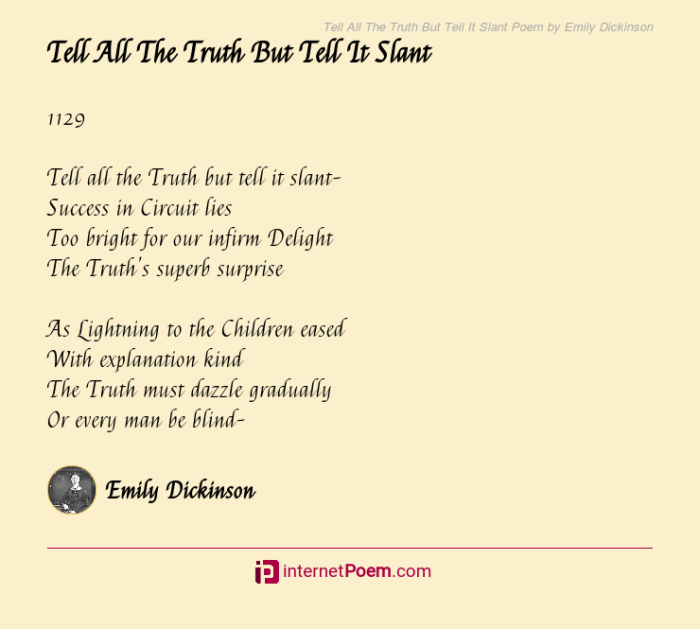Tell all the truth but tell it slant theme – The “Tell All the Truth but Tell It Slant” theme weaves its way through the tapestry of literature, inviting readers to delve into the intricacies of conveying truth through indirect and nuanced means. From Emily Dickinson’s enigmatic poetry to contemporary authors’ innovative techniques, this theme continues to captivate and challenge our understanding of narrative and interpretation.
This exploration will delve into the origins, methods, advantages, ethical considerations, and impact of slanting the truth in literature. By examining real-world examples and diverse perspectives, we aim to shed light on the complexities of this literary device and its profound influence on reader interpretation.
Origins of the Slant Truth: Tell All The Truth But Tell It Slant Theme

The concept of telling the truth “slant” has its roots in historical and literary influences. The phrase gained popularity through Emily Dickinson’s poetry, which often conveyed profound truths through indirect and oblique language.
Emily Dickinson’s Influence
- Dickinson’s poetry employed a unique style that hinted at truths without explicitly stating them.
- Her use of metaphors, symbols, and fragmented language created a sense of ambiguity and allowed for multiple interpretations.
- The “slant” in Dickinson’s poetry allowed readers to discover hidden meanings and engage with the truths on a deeper level.
Methods of Slanting the Truth
Authors employ various literary techniques to convey truth indirectly, including:
Symbolism
Symbols represent abstract ideas or concepts, allowing for nuanced and layered interpretations.
Metaphor
Metaphors create implicit comparisons that suggest a deeper meaning beyond the literal words.
Irony
Irony presents a contrast between what is said and what is meant, often conveying a hidden or satirical message.
Advantages of Slanting the Truth, Tell all the truth but tell it slant theme
Using a slanted approach offers several benefits:
Enhanced Emotional Impact
Indirect truths can evoke stronger emotions than direct statements, creating a lasting impression on readers.
Provoking Deeper Reflection
Slanted truths require readers to actively engage with the text, leading to deeper contemplation and understanding.
Allowing for Multiple Interpretations
Ambiguity allows readers to form their own interpretations, fostering diverse perspectives and discussions.
Ethical Considerations
Slanting the truth raises ethical concerns:
Justification for Withholding or Distorting Information
Authors must carefully consider when it is ethical to withhold or distort information, as it can lead to deception.
Deceptive Purposes
Slanted truths can be used to manipulate or mislead readers, posing ethical dilemmas for authors and publishers.
Slanting the Truth in Contemporary Literature
Contemporary authors continue to employ the concept of slanted truth:
Motivations for Using the Slant Approach
Authors use slanted truths to explore complex themes, challenge perspectives, and evoke emotional responses.
Emerging Trends and Innovations
Modern literature explores new ways of slanting the truth, such as through fragmented narratives, unreliable narrators, and non-linear storytelling.
Impact on Reader Interpretation
Slanted truths influence reader interpretation:
Reader’s Perspective and Knowledge
Readers’ backgrounds, beliefs, and experiences shape their understanding of slanted truths.
Ambiguity and Subjectivity
Ambiguity and subjectivity allow for diverse interpretations, fostering discussions and critical thinking.
FAQ
What is the significance of Emily Dickinson’s poetry in relation to the “Tell All the Truth but Tell It Slant” theme?
Emily Dickinson’s poetry played a pivotal role in popularizing the phrase “Tell all the truth but tell it slant.” Her unique style, characterized by brevity, ambiguity, and unconventional punctuation, challenged traditional notions of truth-telling and encouraged readers to engage with multiple layers of meaning.
How does the use of irony contribute to slanting the truth in literature?
Irony, as a literary device, involves the use of words or situations to convey a meaning that is opposite to their literal or expected interpretation. By employing irony, authors can subtly undermine or subvert the surface meaning, inviting readers to question and re-evaluate the underlying truths.
What are some of the ethical considerations associated with slanting the truth in literature?
Slanting the truth in literature raises ethical questions regarding the responsibility of writers to present accurate information and avoid deception. Authors must carefully navigate the balance between artistic license and the potential consequences of distorting or withholding information, especially when dealing with sensitive or controversial topics.



